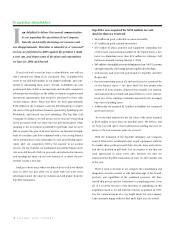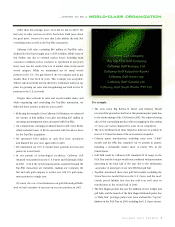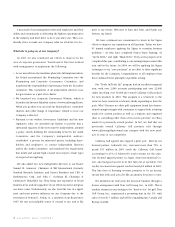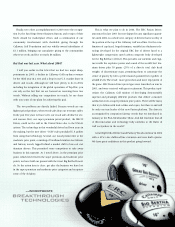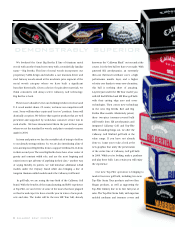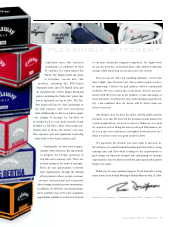Callaway 2003 Annual Report Download - page 14
Download and view the complete annual report
Please find page 14 of the 2003 Callaway annual report below. You can navigate through the pages in the report by either clicking on the pages listed below, or by using the keyword search tool below to find specific information within the annual report.
CALLAWAY GOLF COMPANY 11
Management’s Discussion and
Analysis of Financial Condition
and Results of Operations
The following discussion should be read in conjunction with
the Consolidated Financial Statements, the related notes and the
“Important Notice to Investors” that appear elsewhere in this report.
Regulation G Disclosure
The Company’s discussion and analysis of its results of operations,
financial condition and liquidity set forth in this Item 7 have been
derived from financial statements prepared in accordance with
accounting principles generally accepted in the United States
(“GAAP”). In addition to the GAAP results of operations, the
Company has also provided additional information concerning the
Company’s results that includes certain financial measures not
prepared in accordance with GAAP. The non-GAAP financial
measures included in this discussion are adjusted net income, gross
profit and earnings per share amounts that exclude (i) the 2003
pre-tax charges of $24.1 million associated with the integration of
the Top-Flite Golf business, (ii) the 2002 pre-tax adjustment of
$17.0 million to reduce the Company’s warranty reserve and (iii)
the 2001 pre-tax non-cash energy derivative charge of $19.9 million.
This discussion also includes results of the Callaway Golf brand
operations on a stand-alone basis, although such operations are
not a reportable business segment. These non-GAAP financial
measures should not be considered a substitute for any measure
derived in accordance with GAAP. These non-GAAP financial
measures may also be inconsistent with the manner in which simi-
lar
measures are derived or used by other companies. Management
believes that the
presentation of such non-GAAP financial measures,
when considered
in conjunction with the most directly comparable
GAAP financial measures, provides useful information to investors
by permitting additional relevant period-to-period comparisons of
the historical operations of the Callaway Golf business, excluding
the operations
of the recently acquired Top-Flite Golf business, as
well as information
concerning operations excluding the effect of
significant unusual non-cash charges such as the 2003 Top-Flite
integration charges, the 2002 warranty reserve adjustment and
the 2001 energy derivative charge. The Company has included in
this discussion supplemental information which reconciles those
non-GAAP financial measures to the most directly comparable
financial measures prepared in accordance with GAAP.
Critical Accounting Policies and Estimates
The Company’s discussion and analysis of its results of operations,
financial condition and liquidity are based upon the Company’s
consolidated financial statements, which have been prepared in
accordance with accounting principles generally accepted in
the United States. The preparation of these financial statements
requires the Company to make estimates and judgments that
affect the reported amounts of assets and liabilities and disclosure
of contingent assets and liabilities at the date of the financial
statements and the reported amounts of revenues and expenses
during the reporting period. The Company bases its estimates
on historical experience and on various other assumptions that
are believed to be reasonable under the circumstances. Actual
results may materially differ from these estimates under
different assumptions or conditions. On an on-going basis, the
Company reviews its estimates to ensure that the estimates
appropriately reflect changes in its business or as new infor-
mation becomes available.
Management believes the following critical accounting policies
affect its more significant estimates and assumptions used in
the preparation of its consolidated financial statements:
Revenue Recognition
Sales are recognized when both title and risk of loss transfer to
the customer. Sales are recorded net of an allowance for sales
returns and sales programs. Sales returns are estimated based
upon historical returns, current economic trends, changes in
customer demands and sell-through of products. The Company
also records estimated reductions to revenue for sales programs
such as incentive offerings. Sales program accruals are estimated
based upon the attributes of the sales program, management’s
forecast of future product demand, and historical customer
participation in similar programs. If the actual costs of sales
returns and sales programs significantly exceed the recorded
estimated allowance, the Company’s sales would be signifi-
cantly adversely affected.
Allowance for Doubtful Accounts
The Company maintains an allowance for estimated losses
resulting from the failure of its customers to make required
payments. An estimate of uncollectable amounts is made by



